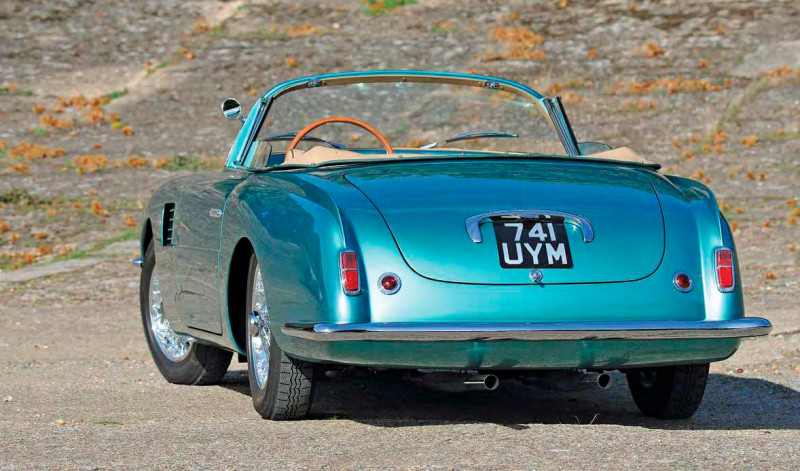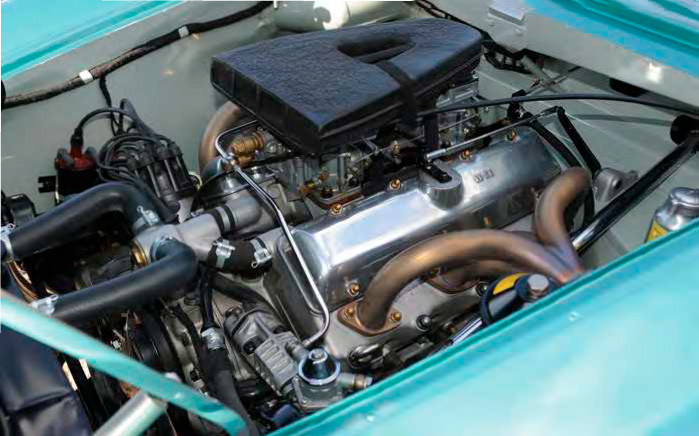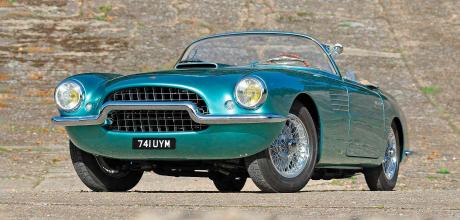1953 Fiat 8V Spider Vignale
Only one Fiat 8V Spider was ever made, bodied by Vignale in 1953. Now it’s been fully restored in the UK – and driving it proves a real revelation.
Story by Paul de Turris
Images by Michael Ward
FIAT 8V VIGNALE
Incredible one-off Otto Vu convertible driven
She’s The One
When Fiat was looking for an original name for its new 2.0-litre V8-powered car, it thought that Ford had a monopoly on the name V8. So Fiat cunningly decided to call its new purpose-built sports car 8V (or ‘Otto Vu’ in Italian), thereby fooling everyone except those ‘in the know’. The original engine design by Dante Giacosa was planned for a saloon but was adopted for (what turned out to be) a limited run of sports racing cars. The 8V was hardly what you would call a commercial success, predominantly due to a hefty price tag, but it was a superb racing machine, and despite the extremely short production run, was hugely successful.

Having been initially unveiled at the 1952 Geneva Motor Show, the last 8V was produced in 1954. A total of 114 vehicles, including rolling chassis, was completed. Easily the largest number of these – around 40 in all – were styled and bodied in-house by Luigi Rapi, all seemingly with differing design details, but largely recognisable as of a ‘generic’ type.
In addition, Fiat supplied rolling chassis to most of the major prolific Italian body styling houses of the time, such as Ghia (which famously produced the stunning Supersonic), Pinin Farina, Zagato and of course Vignale (the latter of which bodied 10 examples). All 8Vs had fixed-head bodywork, with one exception: chassis 0050, supplied to Vignale in 1953, which was ordered from new as an open-topped Spider for one Signor Leone.

This 8V drives like a period sports car, but has loads of go and handling – fast, light and responsive
The convertible’s styling was by Vignale’s favoured stylist at the time, Giovanni Michelotti. A later Vignale-bodied Ferrari 250 one-off, which was built for a European princess, had all the same styling cues as this Fiat. It is possible, since 0050 was known to have made its way to the USA by 1954, that it was decided there was little chance of the two cars ever meeting, so Vignale used the ‘here’s one I made earlier’ approach to its ‘unique’ design. By the way, the only other Fiat 8V known to exist as a convertible was a fixed-head subsequently rebodied by Zagato following extensive damage sustained during racing.

The Otto Vu was a rather highly strung (you could easily substitute the phrase ‘highly unreliable’) racing car. Fiat’s hope was that the whole of the limited production run would be sold locally in Italy, or at least in Europe. But with the appetite for such exotic European fare being so great in post-war America, it was inevitable that some would find their way across the pond to what was then the biggest world market for sports cars. And so it was that, by September 1954, chassis 0050 had already changed hands and was in California. We can only speculate as to why a specially ordered rare sports car was moved on only a year after its completion.

When DTR European Sports Cars was tasked with restoring this unique car in 2015, it forensically dismantled the whole thing. During this process, an opinion was formed that all may not have been perfect with the hasty design and construction of this one-off. With no prior knowledge of this car – which had never before been seen on the shores of the UK – and looking purely at the car from an engineering perspective, there were one or two significant practical issues with its concept. Firstly, after all the paint and filler (of which there was a lot) was taken off, the rear wings had clearly split halfway up to the swage line. Secondly, the car had ‘sagged’ to such an extent that the doors were hitting the rear quarter panels and, once shut, required at least a good shoulder to open. The large fuel cell, mounted behind the rear wheels in the boot, would obviously, when full, add about 100kg to the rear supporting aluminium body, causing excessive stress on the rear wings at their weakest points. The Fiat had long since lost its original windscreen and a plastic affair had been made with modern surrounds. The dashboard and instruments were missing, having been substituted for a simple set-up with Mini-type dials and 1980s switches. The seats were similar to an MGB, with modern fittings and runners, while the door handles were 1970s Alfa. The gearbox was also an Alfa unit, not an uncommon US addition in an age where values were low and Alfa parts were plentiful.

After a few months of research and planning, a total of only seven pictures of the car had been found of the car as it was when new – and no additional images have surfaced since. The photos did, however, reveal the correct layout of the dash, interior and bumpers. The latter are unique to this car and a definite ‘Marmite’ point of discussion with a bit of Americana in there, perhaps.
Over a period of five years, DTR rebuilt the body, removing all the original aluminium and fabricating a discreet spaceframe at the rear to support the fuel tank, remaking the floors and outriggers, and eventually remounting all the original aluminium to finish what was now a convertible with doors that (although 25mm different in length!) shut correctly and didn’t suffer from a lack of support.
DTR then remade the missing rear soft-top frame compartment from marks in the floors where the original item would have sat. It also fabricated the bumpers front and rear, from the original 1953 photo, scaled and measured in 2mm steel. A wooden buck was made for the windscreen and sent away for fabrication in glass, while the aluminium surround was copied from another Vignale-bodied Fiat 8V coupe. No fewer than 3000 hours were spent on the bodywork alone.
The dashboard with glovebox was hand-made in aluminium using the photographs as a guide, and the instruments were made in-house. The biggest challenge in the interior was the main double gauge, unique to Rapi-bodied 8Vs, which could be photographed, measured and scaled. The rev counter and speedo turn in opposite directions, which presented its own problems. The internal door furniture and chrome details were hand-made in steel and brass, then plated to replicate the missing originals faithfully. The rear lights were missing, but are the same as a 1954 Fiat 1100 TV Coupe, of which 26 were made – these were found at the Padova classic car show for £2000! The car was originally painted white with contrasting dark rear fins, but the current owner requested a superb-looking green (a variation of Ferrari Pino Verde).
The engine was fully rebuilt with all new internals, balanced and detailed to run as smoothly as any V8 should. The camshaft was remade from the worn-out original. The gearbox was built from the original castings in Europe and a prop was designed and made to prevent the ‘snap’ that was evident upon take-up. The suspension, brakes and wiring loom were all remade or rebuilt in house.
After being completed in July 2020, the first drive was a revelation. The owner likes to use his cars, but this one was never going to be a tame cruiser, with its camshaft set up for racing and its solid propshaft. Various subtle mods were made, including carbs jetted to minimise stuttering on take-up with that camshaft, and an Aston Martin prop that’s basically two tubes, one inside the other, surrounded by rubber working like a normal prop doughnut. The clutch mechanism was reworked to give a lighter feel, while a new flywheel was made, too.
Despite the apparent oxymoron of being a racing car built as a boulevardier, this 8V is in fact the perfect compromise: it drives like a period sports car, but has loads of go and handling to match. It’s fast, light and responsive, and as happy on the M25 as it is in the windy Kent countryside. This was surely what the original creators had in mind. Wasn’t it?

Dash is hand-made in aluminium, dials counterrotate. Rebuilt V8 now runs super-smoothly. The 8V was once painted red (above); originally white (right); now a variation of Ferrari Pino Verde.


